New Transcription: "Rosaline in the Observatory 3" from Super Mario Galaxy (2007)
A new full sheet music transcription of Rosalina in the Observatory 3 (often called Comet Observatory 3) from "Super Mario Galaxy", complete with sheet music and instrumental part scores.
If you're after the sheet music, score, XML or MIDI for Comet Observatory from Super Mario Galaxy, you can find links here!
This includes individual part scores for:
Full Score
2 Flutes
Oboe
2 Clarinets in Bb
Bassoon
2 Horns in F
2 Trumpets in Bb
2 Trombones
Tuba
Timpani
Suspended Cymbal
Harp
Violin I
Violin II
Viola
Violoncello
Contrabass
If you are one of my Patrons, you can now find the MIDI, XML, SIB files, as well as stems and multitracks I created for this transcription now available to download from your Patreon Google Drive folders!
Arranger's Note:
"The 3rd and final version of the Comet Observatory music, this track appears after defeating Bowser for the 2nd time. It is the largest arrangement of the 3 versions.
Compared to the previous versions of this track, we now have a timpani and a full cohort of both strings and brass. Structurally and harmonically, each version is identical, with only the forces and additional melodic material being altered.
We open with a slowly expanding A dominant chord (A-C#-E-G) acting as a dominant pedal to lead us smoothly to the tonic key of D major (D-E-F#-G-A-B-C#) via a perfect cadence (chord V to I).
At 0:11, we have our perfect cadence into D major with the first of many statements of the Comet Observatory motif alongside a flute countermelody. Harmonically this motif travels fleetingly from D to F# major (0:12; F#-A#-C#) - a tertiary modulation - but still acting functionally as a progression into the subdominant; G major (G-B-D), albeit a highly decorated one with some elements of the Lydian mode (noted by the C# in the strings; 0:14).
From here, we progress up to A major - the dominant - decorated with a suspended 4-3 chord from the strings (D to C#), which then progresses via a perfect cadence back to D major (0:18), although with some suspended chromatic inflections (note the B, G# and E# resolving to A and F#).
At 0:20, the motif begins again with a new countermelody in the cellos. After the progression to G major, we instead get a shift to G minor (G-Bb-D) instead of A major. This then progresses via a plagal cadence (chord IV to I) to a second inversion chord (the 3rd note of the triad in the bass; here, 0:24, the A in a D major chord). This pivots smoothly to a dominant chord (A) which can resolve smoothly back to the tonic in root position (the 1st note of the triad in the bass).
At 0:28, this entire phrase is repeated, now with a countermelody in the horns fleshing out additional harmonies, such as major 7th chords (0:36).
By 0:45, we transition into a brief development phrase in the subdominant (G). The flute takes center stage, doubled by the harp and in conversation with a clarinet, all the while the strings shimmer underneath with a large tremolo pad. This material is briefly taken over by an oboe at 0:54 as we move into more dominant pedal material at 0:58 reminiscent of the opening material of 0:03.
To close the track, we have one final statement of the Comet Observatory motif without any countermelodies (1:01)."



































Yorumlar